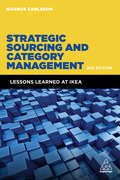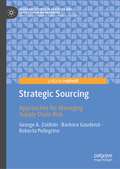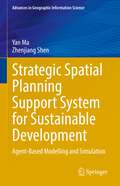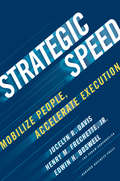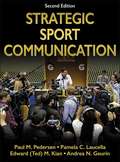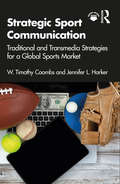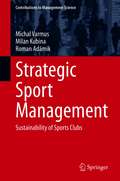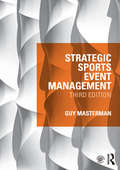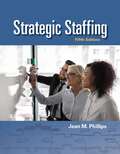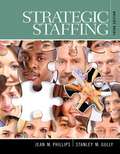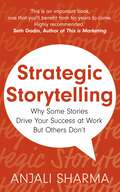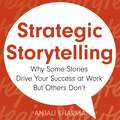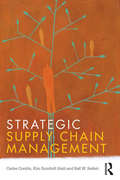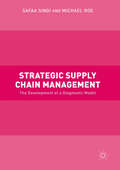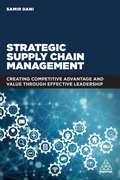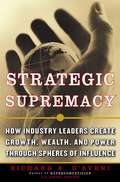- Table View
- List View
Strategic Sourcing and Category Management: Lessons Learned at IKEA
by Magnus CarlssonHow is it possible to sell a kitchen at 30 per cent below market price? Why are hot dogs cheaper in IKEA than in the supermarket? How can IKEA sell the Lack table at half the price it was when it was launched 35 years ago and how can it be achieved with a substantial profit? Strategic Sourcing and Category Management examines how IKEA - and other cost leading companies - use category management to create advantages with direct and indirect sourcing. With 25 years' experience from IKEA, where he had the responsibility to develop and execute the company's purchasing strategy, author Magnus Carlsson shares his insights on important topics: when category management is profitable and why; how teams repeatedly create value and results; what the main approaches are in different categories; how a company implements category management; the difference between success and failure.In this new edition of Strategic Sourcing and Category Management, Magnus Carlsson has added new themes including examples and references from companies such as Maersk, Carlsberg, P&G and Aldi, illustrating the application of cost leadership that spans far beyond IKEA. Even in IKEA, the cost leadership lessons are not limited to home furnishings as the company is sourcing categories such as food, components, materials, transports and indirect materials, with a total purchasing spend of approx. €7 billion. However, maybe even more importantly, the book illustrates how teams create value by thinking differently and asking the right questions, allowing an understanding that goes beyond mere tools and processes.
Strategic Sourcing: Approaches for Managing Supply Chain Risk (Palgrave Studies in Logistics and Supply Chain Management)
by Barbara Gaudenzi George A. Zsidisin Roberta PellegrinoThis book provides a methodology, grounded in prior research, for analyzing supply chain vulnerabilities and determining appropriate strategic sourcing approaches firms can adopt for managing risk and ensuring supply chain resilience. Supply chain risk affects firms in a multitude of ways. The detrimental results of failing to manage supply chain risk includes, but is not limited to, disruptions that lead to the inability of firms to meet customer requirements, increased costs due to holding excessive inventory, paying employee overtime and expediting orders, financial losses due to increases in commodity prices and unfavorable exchange rates, and tarnishing firm reputation due to poor performance. Although supply chain risk can detrimentally affect firms in many ways, there are approaches organizations can implement for identifying, assessing, and managing risk in order to foster resiliency. This work focuses on strategic sourcing approaches for identifying, assessing and managing supply chain risk. It provides readers with insight into strategic sourcing and risk management approaches for managing supply chain risk and attaining resilience and will appeal to researchers in supply chain management, sourcing, and procurement.
Strategic Sourcing: To Make or Not to Make
by Ravi VenkatesanOut of a sense of corporate responsibility, many of today's manufacturers are making commodity-like components to preserve jobs. This single-minded focus on preserving jobs can become a self-defeating objective. It often results in insourcing parts that are easy to manufacture, largely to make work, while outsourcing those that are hard to make. Over time, fixed costs rise, product differentiation declines, and manufacturing performance remains stagnant as employees become complacent. The very survival of the company is threatened. Companies must learn how to not make things: how to not make the parts that divert a company from cultivating its repertoire of skills--parts its suppliers could make more efficiently. Managers must gain the confidence to make strategic discriminations among the thousands of parts they know mostly in terms of cost, not function or importance to the product.
Strategic Spatial Planning Support System for Sustainable Development: Agent-Based Modelling and Simulation (Advances in Geographic Information Science)
by Zhenjiang Shen Yan MaThis book introduces a planning support system called Strategic Spatial Plan Support System (SSP-SS) to visualize population growth and predict energy demand, land use, and waste discharge resulting from urbanization. By analyzing policy interactions between household agents, the book uses SSP-SS to visualize policy effects on urban areas during stages of growth and decline. Simulations are created based on these policy outcome assessments, taking into account the influences of energy and resource consumption on sustainable development in urban environments. The book is geared towards researchers, universities, and urban policy makers.The book begins by presenting a framework of urban growth simulation, and introducing SSP-SS. Then, household lifecycle and relocation models are employed for simulating policy impacts on urbanization, and investigating the impacts of spatial strategic planning. Several projects are assessed using agent-based modeling including shopping centre construction, day-care service for aging populations, and shelter accommodation capacities for earthquakes and other disasters. The final chapters discuss water and energy management, the environmental impacts of demand and consumption, and future recommendations for sustainable development and policy implementation.Introduces Strategic Spatial Plan Support System (SSP-SS) to visualize population growth and predict energy demand, land use, and waste discharge resulting from urbanization.Analyzes policy effects on urban areas during stages of growth and decline.Discusses the influences of water and gas consumption on environmental issues in urban areas for sustainable development.
Strategic Speed
by Henry M. Frechette Edwin H. Boswell Jocelyn DavisOnly 30 percent of strategic initiatives are successfully executed. Of those that are, most CEOs view the process as too slow. What's going on? And how can you accelerate execution in your company?In Strategic Speed, the authors provide the answers. Start by understanding the barriers to execution: Employees don't grasp where an initiative is going. They don't adopt new behaviors. They're not committed to working together to achieve results.Most leaders try to speed things up by changing processes or installing new technologies. But better processes and systems won't remove the barriers. Instead, you need to unleash three people factors-clarity (understanding the goal), unity (collaborating across work groups), and agility (adapting quickly).The authors explain how to unleash these factors by exercising four leadership abilities: Affirming strategies: Ensuring everyone knows the destination and wants to go there Driving initiatives: Accelerating projects called for by your strategy Managing climate: Controlling what it feels like to work in your team Cultivating experience: Harnessing employees' knowledge and expertiseStrategic Speed provides real-world examples-from companies as diverse as Tata Sky, Thermo Fisher Scientific, Ameriprise, and Fender Guitars-showing these practices in action. And it's packed with tools and assessments for diagnosing where your execution efforts are in trouble and choosing specific actions for accelerating results in your firm.
Strategic Sport Communication (2nd Edition)
by Paul Mark Pedersen Andrea Geurin Edward Kian Pamela C. LaucellaStrategic Sport Communication, Second Edition, presents a standard framework that introduces readers to the many ways in which individuals, media outlets, and sport organizations work to create, disseminate, and manage messages to their constituents.
Strategic Sport Communication: Traditional and Transmedia Strategies for a Global Sports Market
by W. Timothy Coombs Jennifer L. HarkerAuthors Coombs and Harker provide step-by-step guidance on how the strategic communication process—an integration of marketing communication, public relations, and advertising—can be applied to sports communication for individual athletes, teams, and leagues. The book is founded on the premise that the strategic communication process in sport communication is grounded in understanding the fans and sources of revenue. Looking at sports globally, it offers readers the traditional multi-step, linear approach to strategic communication message development along with the transmedia narrative transportation method, a non-linear approach that centers on narratives to engage target audiences and urge them to contribute their own material to messaging. With case studies and practical examples, it also highlights additional issues such as race and gender, social media, ethics, and athlete health. It is an ideal text for undergraduate and graduate courses in public relations or strategic communication and sport communication. An online instructor’s manual accompanies the text, including lecture slides; a sample strategic sports communication plan; a test bank; links to key web sites that discuss sports and sports communication concerns; links to case studies with class discussion prompts; sample assignments; a sample course syllabus; and suggestions for further reading.
Strategic Sport Management: Sustainability of Sports Clubs (Contributions to Management Science)
by Michal Varmus Milan Kubina Roman AdámikSport, and in particular the sporting environment, has undergone significant changes in recent decades. The social significance and commercialization of sport; the use of new technologies and organizational structures; and the involvement of various stakeholders matter more today than ever before. This book addresses the key influence of stakeholders in particular on the activities of sports organizations, taking into account certain territorial differences around the world, but also within Europe. The authors explain the key characteristics of the management of sports organizations as opposed to other organizations. These include the strategic management and setting of long-term goals such as sporting success, sustainable funding, youth training, and community building. The authors present a strategic model for these goals and stakeholders in the context of sport, together with research-based case studies in which the critical factors in the strategic management of successful and unsuccessful sports organizations are identified.
Strategic Sports Event Management
by Guy MastermanThis book provides students and event managers with an insight into the strategic management of sports events of all scales and types, from international mega-events to community sport. Introducing key theory and best practice, it offers a practical, step-by-step guide to planning, organizing, managing and evaluating events. Now in a fully revised and updated fourth edition, the book explains the importance of adopting a strategic approach, showing how to implement strategies that lead to successful outcomes over the short and the long term. It uses international case studies in every chapter, from the NBA and NFL to Formula 1 and the English Premier League, offering real-world insight into both larger and smaller events. In addition, woven throughout the book are a series of in-depth studies of several Olympic Games, the ultimate sporting event and an important point of reference for all practising and aspiring event managers. The book covers every key aspect of the sports event management process, including: sports organizations, such as the IOC, FIFA and World Athletics, and their interactions with event partners, the media and promoters short-term and long-term benefits of the planning process event impact and legacy operational functions, including finance, ticketing, transport, venues, IT, human resources and security marketing and communications, including social networking and new media the bidding process research and evaluation This new edition includes expanded coverage of digital and social media, the social impact of events, sustainability, security, entrepreneurship, employability and much more. It is an essential text for any sports event course and invaluable reading for any student or practitioner working in sport business, sport management, sport development or event management. The textbook is supported by useful online resources, including additional case studies and exam questions for each chapter.
Strategic Sports Event Management: Third edition (Hospitality, Leisure And Tourism Ser.)
by Guy MastermanThe hosting of sports events - whether large international events, or smaller niche events - can have a significant and long-lasting impact on the local environment, economy and society. Strategic Sports Event Management provides students and event managers with an insight into the strategic management of sports events of all scales and types, from international mega-events to school sports. Combining a unique conceptual framework with a practical, step-by-step guide to planning, organising, managing and evaluating events, the book explains the importance of adopting a strategic approach, showing how to implement strategies that lead to successful outcomes over the short and long-term. This fully revised and updated third edition uses international case studies in every chapter, from the NBA and NFL to Formula One and the English Premier League, offering real-world insight into both larger and smaller events. In addition, woven throughout the book are a series of in-depth studies of the London Olympic Games, the ultimate sporting event and an important point of reference for all practising and aspiring event managers.The book covers every key aspect of the sports event management process, including sports organizations, such as the IOC, FIFA and IAAF, and their interactions with event partners, the media and promoters short-term and long-term benefits of the planning process event impact and legacy operational functions including finance, ticketing, transport, venues, IT, human resources, and security marketing and communications, including social networking and new media the bidding process research and evaluation. Strategic Sports Event Management is the leading sports event management textbook and is now accompanied by a companion website containing a range of additional teaching and learning features. The book is important reading for all students of sport management or event management, and all practising event managers looking to develop their professional skills..
Strategic Staffing
by Jean M. PhillipsFormerly published by Chicago Business Press, now published by Sage Strategic Staffing equips both current and future managers with the knowledge and skills to adopt a strategic and contemporary approach to talent identification, attraction, selection, deployment, and retention. Grounded in research, this text covers modern staffing concepts and practices in an engaging and reader-friendly format. Author Jean Phillips expertly guides students in developing a staffing strategy that aligns with business objectives, accurately forecasting talent needs, conducting thorough job or competency analysis, and strategically sourcing potential recruits. The Fifth Edition includes the effects of the COVID-19 pandemic on staffing needs worldwide, new coverage of staffing-related technologies, and updated examples throughout, providing students with the latest and most relevant knowledge in the field. Included with this title: LMS Cartridge: Import this title’s instructor resources into your school’s learning management system (LMS) and save time. Don′t use an LMS? You can still access all of the same online resources for this title via the password-protected Instructor Resource Site. Learn more.
Strategic Staffing
by Jean M. PhillipsFormerly published by Chicago Business Press, now published by Sage Strategic Staffing equips both current and future managers with the knowledge and skills to adopt a strategic and contemporary approach to talent identification, attraction, selection, deployment, and retention. Grounded in research, this text covers modern staffing concepts and practices in an engaging and reader-friendly format. Author Jean Phillips expertly guides students in developing a staffing strategy that aligns with business objectives, accurately forecasting talent needs, conducting thorough job or competency analysis, and strategically sourcing potential recruits. The Fifth Edition includes the effects of the COVID-19 pandemic on staffing needs worldwide, new coverage of staffing-related technologies, and updated examples throughout, providing students with the latest and most relevant knowledge in the field. Included with this title: LMS Cartridge: Import this title’s instructor resources into your school’s learning management system (LMS) and save time. Don′t use an LMS? You can still access all of the same online resources for this title via the password-protected Instructor Resource Site. Learn more.
Strategic Staffing
by Jean Phillips Stan M. GullyStrategic Staffing prepares all current and future managers to take a strategic and modern approach to the identification, attraction, selection, deployment, and retention of talent. Grounded in research but full of real-world examples, this text describes how organizations can develop a staffing strategy that reinforces business strategy, leverages staffing technology, and evaluates and improves staffing systems.
Strategic Stakeholder Engagement: A Voice Behind The Curtain
by Chris AnastasiIs it your objective to bring about positive change for your business or organisation by influencing the policy and regulatory environment in which you operate? Do you need to know how to engage with decision-makers in government and other key influencers? Are you looking to pursue or advance your career in Public Relations? Ambitious practitioners working within Public Relations and Corporate Social Responsibility, inside or outside government respectively, and in private or non-profit organisations, will find this an invaluable guide.Revealing insights into the inner workings of government and drawing on real-life case studies, this book offers practical, clear, creative ideas and innovative strategies designed to empower Public Relations professionals to engage with key stakeholders effectively and to influence government policy and regulation. At a time of considerable uncertainty and ever-evolving government policy and regulation, this book shows how it is possible for businesses and organisations to have a voice and make an impact. Chris Anastasi, a recognised authority in Public Relations, has helped national and global organisations influence government and effect major change. He now offers Public Relations practitioners an unmissable chance to become even more effective influencers through his book. Strategic Stakeholder Engagement is essential high-quality reading for anyone involved in public relations, government affairs, lobbying and social responsibility activities in countries around the world.
Strategic Stories: How 3M Is Rewriting Business Planning
by Robert Brown Gordon Shaw Philip BromileyThis article argues that a good strategic plan must be written in a narrative form that tells an exciting, detailed, nuanced story. Virtually all business plans are written as a list of bullet points. Despite the skill or knowledge of their authors, these plans usually aren't anything more than lists of "good things to do." Rarely do these lists reflect deep thought or inspire commitment. Worse, they don't specify critical relationships between the points, and they can't demonstrate how the goals will be achieved. 3M executive Gordon Shaw began looking for a more coherent and compelling way to present business plans. He found it in the form of strategic stories. Telling stories was already a habit of mind at 3M. Stories about the advent of Post-it Notes and the invention of masking tape help define 3M's identity. They're part of the way people at 3M explain themselves to their customers and to one another. Shaw and his coauthors examine how business plans can be transformed into strategic narratives. By painting a picture of the market, the competition, and the strategy needed to beat the competition, these narratives can fill in the spaces around the bullet points for those who will approve and those who will implement the strategy. When people can locate themselves in the story, their sense of commitment and involvement is enhanced. By conveying a powerful impression of the process of winning, narrative plans can mobilize an entire organization.
Strategic Storytelling: Why Some Stories Drive Your Success at Work But Others Don’t
by Anjali SharmaIn today's connection economy, the most successful leaders inspire their people with purpose and meaning. Powerful corporate storytelling can mobilise people around an organisational objective in a way that a focus on market share never will. Be it a digital transformation or a diversity and inclusion initiative, corporate change needs the support of the people in that organisation in order to stick.Yet, while all stories can move people to take action, storytelling isn't a one size fits all. The most effective influencers learn to flex their narrative based on the audience's time or their level of expertise.A story that works on the stage doesn't work in the boardroomA story that works in the boardroom doesn't work in a team meetingA story that works in a team meeting doesn't work in a one-to-one conversation A story that works in one-to-one conversation doesn't work in sales...Anjali Sharma introduces leaders and ambitious influencers to the Who, Why and How of strategic storytelling in business, enabling them bring about change and drive corporate success by telling exactly the right story in the right way.
Strategic Storytelling: Why Some Stories Drive Your Success at Work But Others Don’t
by Anjali SharmaHow to use storytelling to motivate people in your organisation, drive results and advance your careerIn today's connection economy, the most successful leaders inspire their people with purpose and meaning. Powerful corporate storytelling can mobilise people around an organisational objective in a way that a focus on market share never will. Be it a digital transformation or a diversity and inclusion initiative, corporate change needs the support of the people in that organisation in order to stick.Yet, while all stories can move people to take action, storytelling isn't a one size fits all. The most effective influencers learn to flex their narrative based on the audience's time or their level of expertise.A story that works on the stage doesn't work in the boardroomA story that works in the boardroom doesn't work in a team meetingA story that works in a team meeting doesn't work in a one-to-one conversation A story that works in one-to-one conversation doesn't work in sales...Anjali Sharma introduces leaders and ambitious influencers to the Who, Why and How of strategic storytelling in business, enabling them bring about change and drive corporate success by telling exactly the right story in the right way.(P) 2023 Hodder & Stoughton Limited
Strategic Storytelling: Why Some Stories Drive Your Success at Work But Others Don’t
by Anjali SharmaHow to use storytelling to motivate people in your organisation, drive results and advance your careerIn today's connection economy, the most successful leaders inspire their people with purpose and meaning. Powerful corporate storytelling can mobilise people around an organisational objective in a way that a focus on market share never will. Be it a digital transformation or a diversity and inclusion initiative, corporate change needs the support of the people in that organisation in order to stick.Yet, while all stories can move people to take action, storytelling isn't a one size fits all. The most effective influencers learn to flex their narrative based on the audience's time or their level of expertise.A story that works on the stage doesn't work in the boardroomA story that works in the boardroom doesn't work in a team meetingA story that works in a team meeting doesn't work in a one-to-one conversation A story that works in one-to-one conversation doesn't work in sales...Anjali Sharma introduces leaders and ambitious influencers to the Who, Why and How of strategic storytelling in business, enabling them bring about change and drive corporate success by telling exactly the right story in the right way.(P) 2023 Hodder & Stoughton Limited
Strategic Storytelling: Why Some Stories Drive Your Success at Work But Others Don’t
by Anjali SharmaIn today's connection economy, the most successful leaders inspire their people with purpose and meaning. Powerful corporate storytelling can mobilise people around an organisational objective in a way that a focus on market share never will. Be it a digital transformation or a diversity and inclusion initiative, corporate change needs the support of the people in that organisation in order to stick.Yet, while all stories can move people to take action, storytelling isn't a one size fits all. The most effective influencers learn to flex their narrative based on the audience's time or their level of expertise.A story that works on the stage doesn't work in the boardroomA story that works in the boardroom doesn't work in a team meetingA story that works in a team meeting doesn't work in a one-to-one conversation A story that works in one-to-one conversation doesn't work in sales...Anjali Sharma introduces leaders and ambitious influencers to the Who, Why and How of strategic storytelling in business, enabling them bring about change and drive corporate success by telling exactly the right story in the right way.
Strategic Supply Chain Alignment: Best Practice in Supply Chain Management
by John GattornaSupply chain performance will be a key indicator of overall corporate success into the next century. This book, edited by logistics and supply chain expert John Gattorna, and with international contributions, presents unpublished material on next generation thinking about the management of the supply chain. Based on the recently developed strategic alignment model it shows how external market dynamics, the company’s strategic response, and internal capability must be aligned if competitive advantage is to be achieved. Supply chain management is a strategic challenge demanding top level management attention. This book tackles the subject at that strategic level to help companies reposition their supply chains successfully. The book then offers the vital link between strategy setting and implementation, providing comprehensive coverage of the main areas of execution, and making it an essential compendium on all aspects of the subject. With case studies from major organizations from around the world, it is a ’must’ read for anyone wishing to be at the forefront of international supply chain management thinking. Strategic Supply Chain Alignment brings together for the first time the world’s leading logistics professionals, management consultants and academics to offer their insights and experiences on the latest supply chain management techniques. This collection of previously unpublished material offers the reader a unique opportunity to identify the hot issues, discover emerging strategies and uncover key industry and market perspectives. Divided into five sections which reflect the important components of the strategic alignment model, the book covers: ¢ The market: Customer value creation and segmentation, and the rationale behind the integration of supply with demand. ¢ Strategic response: Considers channel strategy, supply chain configuration and operations and distribution management. ¢ Culture: Adopting organization options which focus on deliv
Strategic Supply Chain Management
by Carlos Cordón Kim Sundtoft Hald Ralf W. SeifertThe supply chain is at the heart of every successful business organization's decision-making process. This textbook explains how to create a winning supply chain management strategy by spotlighting how senior executives in European and US companies have turned their supply chains into strategic weapons designed to convert threats, risks and outside pressures into competitive advantages. Strategic Supply Chain Management contains twenty real-world cases, all of which have been field researched by a top author team and tested out in the classroom. Each case adopts an executive leadership perspective to illuminate the real dilemmas faced by managers. The authors draw on their extensive classroom and industry experience to ensure that the writing style is geared towards an executive education readership. This elite case package will provide a complete teaching resource and authentic learning experience for MBA and executive education classes in Supply Chain Management throughout the world.
Strategic Supply Chain Management
by Michael Roe Safaa SindiThis book analyses the development of strategic supply chain modelling and its role in optimising decision-making in business, in relation to advances in technology and increased demand due to globalisation. The authors examine existing supply chain models in order to create a conceptual framework for a new diagnostic tool, offering a useful, realistic and meaningful contribution to the field, both theoretically and practically. Using the real-life context of a major international automobile manufacturer, this study satisfies the demand from industry for guidance in the complex world of strategic supply chain modeling in the growing logistics business sector. Readers of Strategic Supply Chain Management will find this work instructive and informative, and it will be of particular interest to students, researchers and policy-makers in the supply chain management industry.
Strategic Supply Chain Management (EAI/Springer Innovations in Communication and Computing)
by Zhang Yu Syed Abdul KhanThis book covers the scope of supply chain and logistics, which has continued to grow with a rapid speed. The book includes core aspects of supply chain and logistics philosophy and practice. The authors then cover the general principles of supply chain and logistics that can be applied in countries throughout the world. Where concepts cannot be generalized, they are based primarily on a European model. The authors have also added some international material and examples from China, Pakistan, India, and the USA. The book is intended to help in the quest of supply chain and logistics to reduce cost and improve service, as well as to keep up-to-date the different facets of supply chain and logistics in a global market. In addition, this book helps candidates to who are undertaking examinations for universities and professional institutes, and bachelor and master students who are studying for degrees in supply chain management. In addition, the book covers technical terminologies, definitions, and a supply chain dictionary.
Strategic Supply Chain Management: Creating Competitive Advantage and Value Through Effective Leadership
by Samir DaniSupply chains, including logistics, are the functional elements of an organisation's operations. To formulate a strategy for this operation to work seamlessly the organisation needs to align these operations with the corporate and business strategy. Strategic Supply Chain Management provides a discussion on effective supply chain strategic leadership for managerial teams who have previously been operating on a tactical or operational level, as well as students who need to learn about applying the theories of strategic supply chain management in practice. Strategic Supply Chain Management introduces concepts and tools which will enable successful buyer-supplier relationships and effective organizational leadership and talent management. Samir Dani provides a concise but important outlook on the connection between business strategy and supply chain strategy. The book delves into topical issues of risk, resilience, and sustainability and how these influence both business and supply chain strategy. The book also considers strategies for procurement, buyer supplier relationships, and sales & operations planning. An important aspect of this book is to consider the leadership and talent aspects of the humans in the supply chain and how this influences strategy and creates competitive advantage.
Strategic Supremacy
by Richard A. D'AveniAre upstart competitors taking deadly aim at your company's products and markets? Richard A. D'Aveni, author of the famous attacker's handbook Hypercompetition, presents coun-terrevolutionary strategies and tactics that any industry leader or established company can use to defend itself against revolutionaries, disrupters, or hypercompetitors. The secret lies in making the rules, not breaking them, D'Aveni says, because rule makers still rule. Arguing that "profits and prosperity come not from revolution but stability and orderly change," D'Aveni presents a commanding framework that will enable any resource-rich or clever defender to gain Strategic Supremacy by being first to define the playing field. D'Aveni demonstrates how global powerhouses such as Disney, Microsoft, and Procter & Gamble have achieved preeminence by reconceptualizing their product portfolios as powerful competitive arsenals he calls "spheres of influence." Essentially a new way to compete by restructuring portfolios around a core geographic/product market, spheres enable any company to influence the behavior and positioning of rivals. In immensely readable prose, D'Aveni describes how prevailing spheres of influence can be used to create legal business equivalents to a "concert of powers" and other industry structures that mix cooperation with competition. Just one of the potent functions of a corporate sphere, D'Aveni shows, is to contain competitors of equal size (as NBC contained ABC). Spheres can also be used to stabilize an entire industry's global power system. A glance at the detailed table of contents will provide a sense of the wealth of new information contained in this essential handbook of global warfare, including "how-to" tools the reader will need to measure and map the pattern of competitive pressure in any industry and to interpret the meaning and strategic implications of these pressure patterns for his or her position within the industry's power hierarchy.
